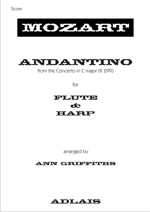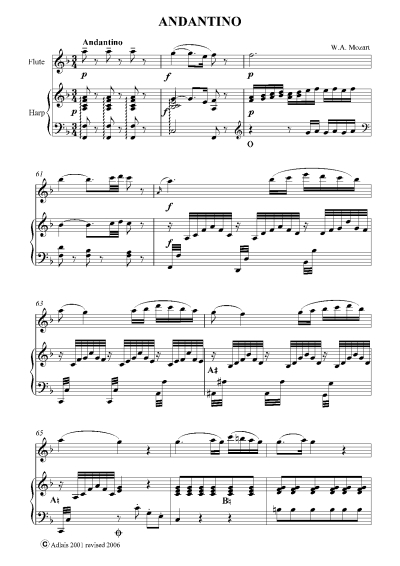 |
|||
| |
of Harp Music |
| © 2004-2025 ADLAIS |
| Andantino
from
the Concerto in C major (K 299) WA Mozart (1756-1791) arr. Ann Griffiths |
return to previous page |
 |
Work: | Duet for Flute & Harp |
| Catalogue No: | Adlais 104 | |
| ISMN: | 979-0-57032-093-6 | |
| Edition: | June 2006, A4 stapled, harp score & flute part | |
| Suitable for: | Grade 5 Flute & Lever or Pedal Harp | |
| Price:: | £7.00 Go to shop | |
Mozart's Concerto for Flute and Harp (K 299) was composed in Paris in 1778, in response to a commission from the Comte de Guines. A career diplomat, as Adrien-Louis de Bonnières de Sourastre, Duc de Guines, he had been appointed French Ambassador to London's Court of St James in 1774. Recalled to France in 1776, on his return he was elevated to the status of Count at the insistence of Marie Antoinette, of whom he was a firm favourite. The Comte de Guines played the
flute and his daughter played the harp. Having recently arrived
in Paris on 28 March, the twenty-one-year-old Mozart was engaged
to give the daughter lessons in composition, a discipline at
which she proved to be a fairly inept pupil, though Mozart was
generous enough to describe her harp playing as 'magnifique'.
It is more than likely that her harp teacher was J
B Krumpholtz,
and it is also more than likely that she played a single-action
harp by Naderman, with whom her teacher Krumpholtz was closely
associated. What is unlikely is that the Concerto was ever performed
by the Comte and his daughter – there is no record of any
such performance, and in fact, five months later Mademoiselle de
Guines had abandoned the harp and married the Duc de Castries,
the unfortunate Mozart receiving only three gold louis (half the
sum he was owed) as payment for the 24 two-hour lessons he had
given her. Original classical concert duos for the combination of flute and harp are rare, and Adlais's aim in presenting this edition of the Andantino from Mozart's Concerto (the only surviving manuscript, in Cracow, Poland, calls it a 'Concertante') was to extend the available repertoire for flute and harp, and to provide a useful recital item in a form which could be played by a duo, without orchestra. Starting at bar 58, bar numbers have been left as in the original edition, so that when the orchestral accompaniment is in place and the performers are concerto soloists, they can still play the Concerto without changing a note of the edition presented here. A favourite cadenza can be inserted from the wide available choice. The flute part has been edited by Jane Groves, whilst the harp part has been edited by Ann Griffiths. With minimal modification (bars 64, 86, 102,112), the harp part can be played on Celtic or lever harp. © Ann Griffiths 2006 |

